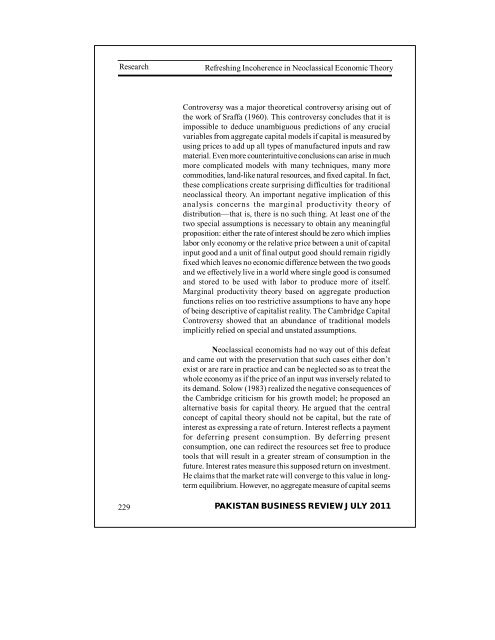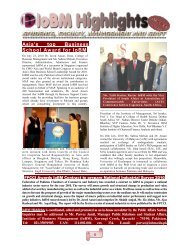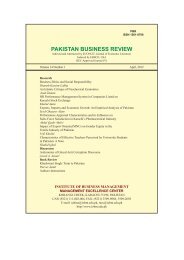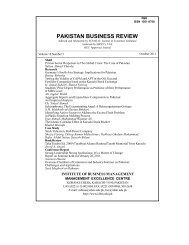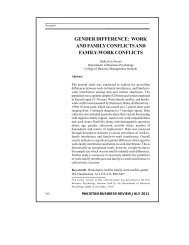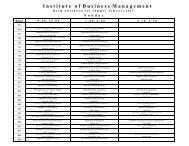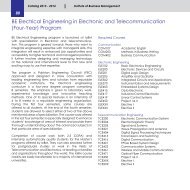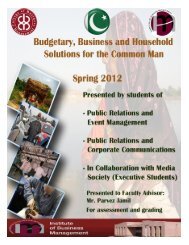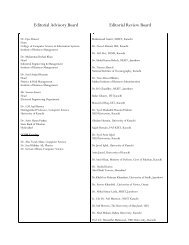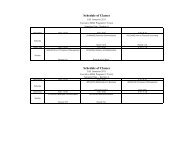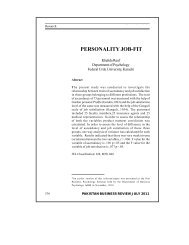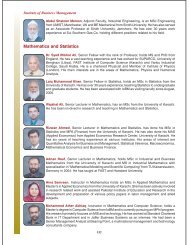PAKISTAN BUSINESS REVIEW - Institute of Business Management
PAKISTAN BUSINESS REVIEW - Institute of Business Management
PAKISTAN BUSINESS REVIEW - Institute of Business Management
Create successful ePaper yourself
Turn your PDF publications into a flip-book with our unique Google optimized e-Paper software.
Research<br />
Refreshing Incoherence in Neoclassical Economic Theory<br />
Controversy was a major theoretical controversy arising out <strong>of</strong><br />
the work <strong>of</strong> Sraffa (1960). This controversy concludes that it is<br />
impossible to deduce unambiguous predictions <strong>of</strong> any crucial<br />
variables from aggregate capital models if capital is measured by<br />
using prices to add up all types <strong>of</strong> manufactured inputs and raw<br />
material. Even more counterintuitive conclusions can arise in much<br />
more complicated models with many techniques, many more<br />
commodities, land-like natural resources, and fixed capital. In fact,<br />
these complications create surprising difficulties for traditional<br />
neoclassical theory. An important negative implication <strong>of</strong> this<br />
analysis concerns the marginal productivity theory <strong>of</strong><br />
distribution—that is, there is no such thing. At least one <strong>of</strong> the<br />
two special assumptions is necessary to obtain any meaningful<br />
proposition: either the rate <strong>of</strong> interest should be zero which implies<br />
labor only economy or the relative price between a unit <strong>of</strong> capital<br />
input good and a unit <strong>of</strong> final output good should remain rigidly<br />
fixed which leaves no economic difference between the two goods<br />
and we effectively live in a world where single good is consumed<br />
and stored to be used with labor to produce more <strong>of</strong> itself.<br />
Marginal productivity theory based on aggregate production<br />
functions relies on too restrictive assumptions to have any hope<br />
<strong>of</strong> being descriptive <strong>of</strong> capitalist reality. The Cambridge Capital<br />
Controversy showed that an abundance <strong>of</strong> traditional models<br />
implicitly relied on special and unstated assumptions.<br />
Neoclassical economists had no way out <strong>of</strong> this defeat<br />
and came out with the preservation that such cases either don’t<br />
exist or are rare in practice and can be neglected so as to treat the<br />
whole economy as if the price <strong>of</strong> an input was inversely related to<br />
its demand. Solow (1983) realized the negative consequences <strong>of</strong><br />
the Cambridge criticism for his growth model; he proposed an<br />
alternative basis for capital theory. He argued that the central<br />
concept <strong>of</strong> capital theory should not be capital, but the rate <strong>of</strong><br />
interest as expressing a rate <strong>of</strong> return. Interest reflects a payment<br />
for deferring present consumption. By deferring present<br />
consumption, one can redirect the resources set free to produce<br />
tools that will result in a greater stream <strong>of</strong> consumption in the<br />
future. Interest rates measure this supposed return on investment.<br />
He claims that the market rate will converge to this value in longterm<br />
equilibrium. However, no aggregate measure <strong>of</strong> capital seems<br />
229<br />
<strong>PAKISTAN</strong> <strong>BUSINESS</strong> <strong>REVIEW</strong> JULY 2011


